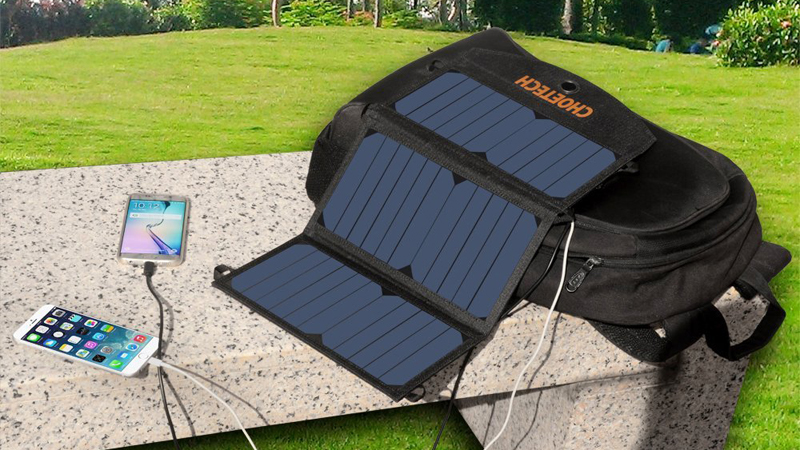At PC Advisor we regularly review power banks, which you can slip into a pocket or bag and use to re-charge your phone, tablet or other USB-powered device whenever you’re running out of juice and away from the mains. However, even the highest-capacity power banks will eventually run out of charge, and then you’re stuck until you next reach mains power. Unless, that is, you buy a solar charger. Harnessing their power from the sun’s rays, solar chargers need never be plugged into a mains power point, and given enough exposure to the sun could mean you never need to pay to charge your phone or tablet again.
Now that we’re reaching the end of summer in the UK it seems a strange time to be discussing the use of solar power, but you actually don’t need bright sunshine. Sure, the more sunshine there is the faster your device will charge, but even at this time of year you can get enough juice to get you out of a jam. And remember, much of the world outside the UK sees sunshine this time of year, so a solar charger could be a handy travel companion if you’re planning a trip away. Also see: How to improve smartphone battery life. Both solar chargers have a fold-out design with three large solar panels and a dual-output box for connecting your phone and/or tablet. The CHOEtech wins on design, more compact (530x260mm, 480g against the Marsboy’s 810x260mm, 677g) and with a zipped mesh pouch with interior strap on the rear for carrying your smartphone or small-screen tablet and the necessary cables. The Marsboy also has a pouch for your phone or tablet, although it is secured here with only a small piece of Velcro. When closed the Marsboy is held together with Velcro, too, whereas the CHOEtech uses magnets, which just feel slicker. Both are water- and dust-resistant.
Either solar charger can be hung from a tree or whatever you have to hand, rather than laid out on the grass where your precious tech is at risk of being crushed underfoot, although again the CHOEtech has the slight edge. A top-mounted metal-reinforced ring and four material loops at each corner of the device make hooking it up simpler than the four metal-reinforced rings at each corner of the Marsboy. Also see: Best desktop chargers 2015. But it’s not all about design, especially when your overall aim is to get as much free power for your phone or tablet as you possibly can. And in performance the Marsboy takes the upper hand, even if its ’15W’ description makes it sound inferior to the ’19W’ CHOEtech. It’s solar panels may be less efficient, but they are also larger. The Marsboy features two fast charging ports rated at 10.5W and 12.5W respectively, while the CHOEtech has two 12W outputs with intelligent technology that can recognise your device and deliver the optimum charge. Technically, with one device connected to its faster port the Marsboy can charge that device ever so slightly faster than can the CHOEtech (provided, of course, that the connected device can handle all 12.5W). And so it did in our real-world tests. Read next: How to solar-charge a MacBook
We tested each solar charger with an HTC Desire Eye last weekend. The temperature according to the phone was 16ºC, with mostly blue skies and very little cloud cover. It was a pleasant day for mid-September, but even in the UK we can experience much sunnier days earlier in the summer. With the HTC Desire Eye plugged into the Marsboy we managed to give its 2400mAh battery a 32 percent boost in 1 hour. Connected to the CHOEtech we saw a 19 percent boost in 1 hour. Neither offered a massive amount of power, but if you have no other means of charging your phone then you’re unlikely to turn down 32 percent. (You’re certainly not going to turn it down in exchange for a 19 percent boost.) Given sunnier weather conditions you’ll see better results, so if you’re planning to spend a couple of hours sunbathing by the pool or fishing by the lake then a solar charger could be a very useful companion. Something these two solar chargers have in common is that neither has a built-in battery, as we saw with Olixar’s alternative. The Olixar enCharge KP-8000, which is no longer available, has an 8000mAh built-in battery and four smaller solar panels. This allows you to store up power for later use, rather than hoping the sun is still shining when your battery has depleted. It also means you can recharge the power bank from the mains when possible, then keep it topped up with solar power. Read next: How to charge your phone or tablet faster Follow Marie Brewis on Twitter. Marie is Editor in Chief of Tech Advisor and Macworld. A Journalism graduate from the London College of Printing, she’s worked in tech media for more than 17 years, managing our English language, French and Spanish consumer editorial teams and leading on content strategy through Foundry’s transition from print, to digital, to online - and beyond.


